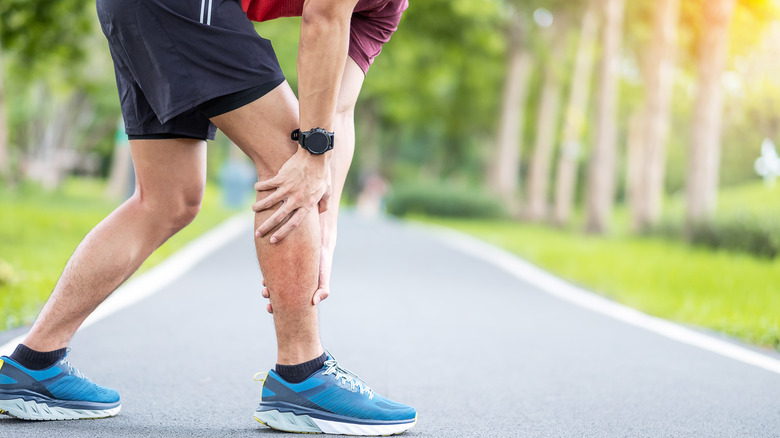What Does It Feel Like When You Pull A Muscle?
Contrary to popular belief, avid sports players are not the only people prone to pulling a muscle. Otherwise referred to as a muscle strain, a pulled muscle pertains to muscle fibers that have been stretched or torn, according to American Family Care. Most often, it's due to a muscle having been stretched beyond its normal range of motion or when a muscle contracts too harshly. Muscle strains are frequently seen in the neck, shoulders, hamstrings, and lower back area.
There are three different categories of muscle strains, each increasing in severity, reports Hospital for Special Surgery (HSS). Damage inflicted to less than 5% of muscle fibers constitutes a Grade 1 strain. In these cases, there is generally no significant loss of strength or motion within the muscle. A Grade 2 muscle strain involves more substantial damage, including a loss of strength and motion, but the muscle has not entirely ruptured. For athletes, the recovery period often spans two to three months. In a Grade 3 muscle strain, the muscle has completely ruptured and, in some cases, the affected tendon and muscle may only be able to be reattached through surgical means.
It certainly sounds painful, but what exactly does pulling a muscle feel like in the moment?
Symptoms of a pulled muscle
One sign that you've experienced a muscle strain is noticing sharp pain immediately after making an abrupt movement that feels 'wrong', notes American Family Care. Even more specifically, experts at Hospital for Special Surgery (HSS) liken the pain to being stabbed. Healthline states that others describe it as a knotted-up sensation. Additional symptoms of a pulled muscle may include soreness, weakness, bruising, stiffness, swelling, muscle spasms, and limited mobility.
According to Healthline, while a pulled muscle can be the result of a sports injury, muscle strains can also occur in relation to slips or falls, lifting or throwing something heavy, as well as running or jumping. Stiff muscles during the colder months of the year can also make one more susceptible to strains.
With at-home treatment, mild to moderate cases of muscle strains generally heal within a few weeks. Suggested treatments include the RICE method: Rest, Ice, Compression, and Elevation of the affected area.
Over-the-counter pain medications such as ibuprofen or acetaminophen can help alleviate swelling and discomfort. Additionally, after the first three days following injury, apply heat to the area a few times per day to boost blood flow.
Healthline recommends seeking medical attention if the injury involves blood or numbness, you can't walk, you can't move your legs or arms, or the pain persists for more than a week.
In severe cases, experts at HSS state that surgery may be necessary, or platelet-rich plasma injections may be used to help the affected muscle tissue regenerate more quickly.

